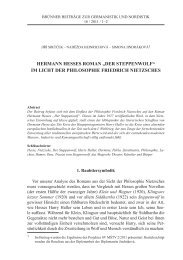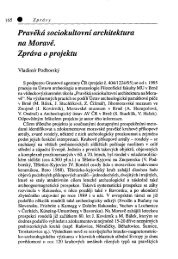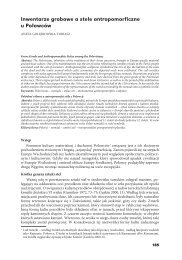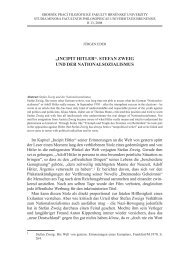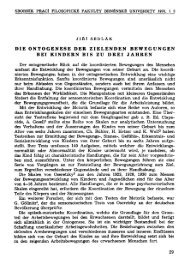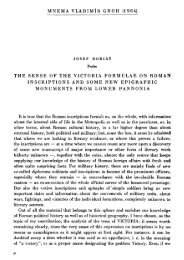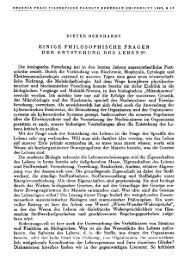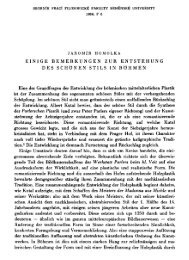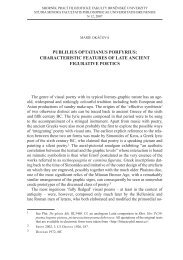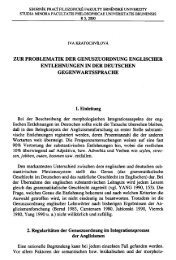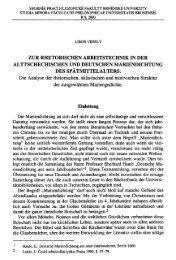english and german equivalents of the czech adverb of manner ...
english and german equivalents of the czech adverb of manner ...
english and german equivalents of the czech adverb of manner ...
Create successful ePaper yourself
Turn your PDF publications into a flip-book with our unique Google optimized e-Paper software.
adjuncts that in some way define <strong>the</strong> process denoted by <strong>the</strong> verb (referred toas process adjuncts in Quirk et al., 459) <strong>and</strong> subject adjuncts. There seems tobe a whole scale <strong>of</strong> types, differing in <strong>the</strong> intensity <strong>of</strong> <strong>the</strong>ir relation to <strong>the</strong>referent <strong>of</strong> <strong>the</strong> subject on <strong>the</strong> one h<strong>and</strong> <strong>and</strong> <strong>the</strong> action on <strong>the</strong> o<strong>the</strong>r. Theestablishment <strong>of</strong> such a scale lies, however, beyond <strong>the</strong> scope <strong>of</strong> <strong>the</strong> presentstudy <strong>and</strong> must be left to fur<strong>the</strong>r research. Here we shall limit ourselves toa few illustrative examples ranging from an instance in which <strong>the</strong> MA-subjectrelation prevails (80), through one in which <strong>the</strong> MA-subject relation <strong>and</strong> <strong>the</strong>MA-verb relation seem to be <strong>of</strong> approximately <strong>the</strong> same intensity (81), toan instance in which <strong>the</strong> MA is a typical process adjunct (82).80. Perhaps he was happily making money out <strong>of</strong> girls in Cholon. G 28. 1681. "That is not strong enough," he said, <strong>and</strong> took it <strong>and</strong> tasted it himself, carefully rinsedit <strong>and</strong> refilled it from a second teapot. G 140.1582. ... <strong>and</strong> I distinctly heard a woman behind me sniffing back her tears. B 36.9For <strong>the</strong> reasons mentioned above, we shall refrain from making an exactstatistical evaluation <strong>of</strong> subject adjuncts <strong>and</strong> process adjuncts. Though subjectadjuncts obviously prevail in M2 position instances, examples <strong>of</strong> typicalprocess adjuncts turn up on rare occasions as well (cf., e. g., ex. 82 quotedabove). On <strong>the</strong> o<strong>the</strong>r h<strong>and</strong>, subject adjuncts are also found in E (as instancedby ex. 83 below), though less frequently, <strong>and</strong>, as we shall see fur<strong>the</strong>r on, in Iposition.83. I went back lwpelessly to my bed in <strong>the</strong> rue Catinat. G 33.25Our material corroborates <strong>the</strong> statement <strong>of</strong> Quirk et al. (469) that <strong>the</strong> mostfrequent positions <strong>of</strong> subject adjuncts are M <strong>and</strong> I.We may now proceed to <strong>the</strong> next sentence position, namely El. Since <strong>the</strong>MA is <strong>the</strong> only element following <strong>the</strong> verb in El position instances <strong>and</strong> since,in most cases, <strong>the</strong> elements preceding <strong>the</strong> entire verb form are <strong>the</strong>matic, <strong>the</strong>MA performs <strong>the</strong> function <strong>of</strong> rheme proper. Let us quote two examples instancingthis type.84. Pyle <strong>of</strong>fered him a Vit-Health s<strong>and</strong>wich, which he refused politely. G 98.1985. He had laughed nervously <strong>and</strong> said ... G 86.19The type illustrated above is by far <strong>the</strong> most frequent within <strong>the</strong> discussedposition, occurring in all but one El position instances found in <strong>the</strong> materialexamined. Let us now quote <strong>the</strong> only instance in which an El positioned MAis prevented from performing <strong>the</strong> function <strong>of</strong> rheme proper.The <strong>adverb</strong>ial <strong>of</strong> place from <strong>the</strong> plain denotes <strong>the</strong> scene, <strong>the</strong> verb rose appearanceon <strong>the</strong> scene <strong>and</strong> <strong>the</strong> MA unchangingly <strong>manner</strong> <strong>of</strong> <strong>the</strong> appearance.All <strong>the</strong> elements are surpassed in CD by <strong>the</strong> subject, which denotes <strong>the</strong> thingthat appears on <strong>the</strong> scene (cf. Firbas 1966. 243—9). Thus semantic-contextualmeans, operating counter to <strong>the</strong> basic distribution <strong>of</strong> CD, let an elementpreceding <strong>the</strong> verb, namely <strong>the</strong> subject, function as rheme proper.86. From <strong>the</strong> plain <strong>the</strong> mortar bursts rose unchangingly ... G 58.27E2 bears a certain resemblance to M2 in that <strong>the</strong> verb is followed by atleast one sentence element o<strong>the</strong>r than <strong>the</strong> MA. It differs from M2, however,in having <strong>the</strong> MA placed after <strong>the</strong> verb <strong>and</strong> followed in its turn by <strong>the</strong> o<strong>the</strong>rsentence element(s). The sentence element following <strong>the</strong> MA may be a pre-86



